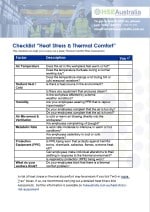Heat Stress Assessment
at the workplace
Why a Heat Stress Assessment should be part of your Risk Assessment Process.
Workplaces in various industries and trades are predestined to represent an increased risk of workers experiencing heat stress or thermal discomfort. This is mainly due to the specific workplace set-up (e.g. outside in the sun), the machines or plant used (e.g. large machinery) or the type of work employees are tasked with (e.g. physically demanding work).
Thermal discomfort and heat stress can lead to a variety of heat-related illnesses and failure to monitor and manage Thermal Stress can increase the risk of workers being injured.
A thorough thermal assessment including a heat map is advisable to mitigate risks.

What is Defined as Heat Stress at Work?
The human body tries to maintain a core body temperature of 37 degrees Celsius. If the body temperature is increasing past that level, humans will experience psychological and a physiological stress. This is called heat stress or thermal discomfort.
However, it is common for many workers while performing physically demanding tasks to experience mild forms of heat stress during their work. In most cases, the body will react to that by trying to cool down by producing sweat, or by laboured breathing practices such as panting.
Heat becomes a health risk when the body is unable to lose extra heat and reduces the internal body temperature to the normal level. This can be due to the environment at the workplace such as a smelter or factory, or if working outdoors during summer, the type of clothing and Personal Protective Equipment (PPE) the workers wear, or if the type of work they are performing is physically demanding.
The opposite of heat stress is cold stress (1), which workers in Australia usually experience when working outdoors in winter, or while working at climate-controlled workplaces such as cool rooms or refrigerated trucks and storage units.

What Are typical Sources of Thermal Stress?
Thermal stress at a workplace can originate from various sources, such as extreme weather conditions, machinery, or the clothes or equipment employees and worker’s wear.
Especially in the manufacturing and construction industry workers are often experiencing heat stress. Industry workers that are surrounded by heavy machinery radiating heat, and are required to wear heavy PPE, are the most common at risk of thermal stress. This heavy PPE further insulates the body, trapping heat and putting a restriction on breathing, potentially causing extreme thermal stress.
Similarly, construction workers and traffic workers often must perform their duties in an outdoors setting, being exposed to the sun or cold temperatures for hours.
Typical sources for heat stress are:
- Machinery radiating heat
- Geothermal radiation (mining)
- Exposure to extreme weather conditions
- Physically demanding work
- Body heat trapped by wearing PPE
- Etc.
Identifying all potential sources of thermal stress and addressing them accordingly, such as by giving workers access to heated or cooled break areas, a higher frequency of work breaks from physically demanding work, or access to cool beverages as adequate hydration is an important part of a thorough risk assessment and risk management process.

What are signs and effects of heat stress?
Extreme heat or cold at work are dangerous to workers’ health and can prove fatal if left unmanaged. Even if employees are provided with the correct clothing, well advised & trained, and provided adequate break in climatised rooms, prolonged exposure can have long-term effects.
The immediate effect of heat stress includes exhaustion, lack of concentration, dizziness, cramps, and rashes. Higher temperatures are also linked to respiratory issues and in some situations, a heat stroke is possible.
Furthermore, heat is known to exacerbate pre-existing medical issues, such as heart disease or high blood pressure.
The importance of keeping employees cool is an often-overlooked part of occupational health and safety best practice.
The effects of cold on a worker’s body are often more subtle. The body manages cold temperatures by insulating itself from the cold by narrowing the skin’s blood vessels and by shivering to generate heat if that fails. Sign of cold stress can include rashes, reded skin, numbness, and shivering.
Failure to monitor and manage the thermal environment of a workplace may result in workers passing out on the job or an increase to the risk of accident occurrence.

Download the SafeWorks SA Infographic as PDF
What is a Thermal Comfort Assessment?
Thermal comfort refers to how comfortable people feel in a building or their work area. A simple way to assess the comfort level is by having a safety representative use a thermal comfort checklist. A simply thermal comfort self-assessment checklist can include questions such as:
- Does the air feel warm or hot?
- Is there a heat source in the environment?
- Are workers performing physical tasks (hard work) in hot conditions?
- Are employees sedentary in cool or cold environments?
- Do your employees complain about the ambient temperature?
Please download your free Heat Stress Assessment Checklist
In more complex work environment a thorough heat assessment, including a heat map, is advisable.
If thermal comfort is a concern, the PCUB or a safety representative will have to consider conducting a holistic assessment as part of their risk assessment. Discomfort at work could be the first sign that there is a problem.
How Can a Company Reduce Heat Stress for Workers?
There are some ways businesses can reduce the risk associated to them.
- A first step must be to identify if a worker is fit to work in thermally challenging conditions and work environments.
- The next step should be to establish a heat illness prevention program and to provide education and training for workers to be made aware of the risks of heat stress occurring during their day-to-day work.
- Allowing workers to spend enough time to acclimatise to their work area or environment is essential.
- Reducing a workers' exposure by allowing plenty of breaks and rotating staff.
- Providing appropriate clothing for the work environment and easy access to cold water or heated drinks.
- Most importantly, assessing the work site for risks of heat stress and before workers enter a work area to assure health and safety.
Workers in various work environments, inside and outside, are exposed to heat or cold. To ensure that this exposure is not leading to thermal discomfort or any health or safety concerns, the workplace should be mapped and monitored.

Health Safety Environment Australia specializes in services around Occupational Hygiene, Occupational Health & Safety and Hazardous Material related assessments.
We help our clients to understand health and safety risks at their workplace and how to mitigate them. Our team of experts is experienced conducting Risk Assessments that include Thermal Comfort assessment, heat mapping and temperature monitoring.
If you have any concerns regarding Themal Comfort at your workplace, please contact us on 1300-SAFETY or request a call back.
HSE Australia’s team of Occupational Hygienists Specialists is available 24/7 and Australia-wide.
Request A Call Back
References
- https://www.safework.nsw.gov.au/hazards-a-z/cold-environments
- https://www.safeworkaustralia.gov.au/system/files/documents/1902/guide_for_managing_the_risks_of_working_in_heat_1.pdf
Creation: Bernd Jahnke (Content)
Revision: Elliot Turner (Occupational Hygiene Technician)
Approved: Dr. Michael Tkaczuk (Occupational Hygienist)
Published: Health Safety Environment Australia Sep2022


